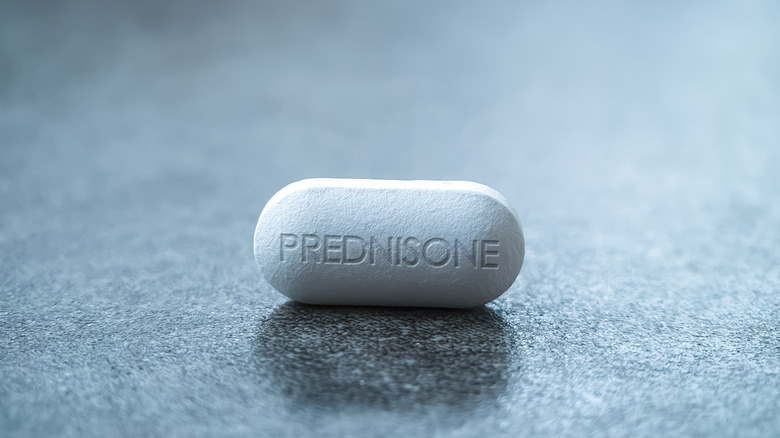What To Expect If You Stop Taking Prednisone Too Quickly
Prednisone is a corticosteroid medicine that controls an overactive immune system (via Drugs.com). When the immune is overactive, it fights against substances, like allergens, that may not be harmful, making you more vulnerable to allergic reactions (via Johns Hopkins Medicine). In extreme cases, your immune can attack its own tissues, resulting in more serious autoimmune conditions.
Prednisone's mechanism of action helps control these conditions that make your immune system attack tissues by mistake, as stated by Mayo Clinic. Corticosteroids, like prednisone, reduce inflammation, and other immune-related symptoms. It's also used to treat symptoms of low and normal cortisol levels, which are often linked to conditions like arthritis, multiple sclerosis, lupus, and organ malfunction (via Medline Plus). The dosage for prednisone often differs from person to person depending on various factors, such as your medical condition and the strength of the medicine, per Mayo Clinic.
If you're currently on prednisone, it's best to consult with your doctor before stopping it. Quitting the medication too quickly might result in unwanted prednisone side effects and withdrawal symptoms.
Common withdrawal symptoms of prednisone
When you take prednisone for a long period of time, your adrenal glands might make less cortisol than the body needs to function, according to the Hospital for Special Surgery (HSS). Cortisol is an essential hormone that control's the body's response to stress (via Medical News Today). It also regulates blood sugar, controls metabolism, and lowers inflammation.
If you have an imbalance in cortisol production, you might experience various prednisone side effects and withdrawal symptoms when you stop taking the medication, per HSS. These symptoms include body aches, mood swings, and chronic fatigue (via Medical News Today). Some people might also experience unexplained dizziness or joint pains as well. However, more severe withdrawal symptoms, such as breathing difficulties and adrenal crisis, can be fatal, according to WebMD. Keep in mind, withdrawing can also go as far as triggering critical mental health disorders, like depression, anxiety, mania, or delirium.
The best way to stop taking prednisone
To properly go off prednisone, you'll need a taper schedule so your body can start producing the right amount of cortisol, according to Drugs.com. A tapering schedule is especially important if you've been taking prednisone for a long time and your body's natural cortisol production has been suppressed. Your doctor might create a prednisone tapering schedule to reduce the chances of severe withdrawal symptoms. These symptoms might still occur even if you follow your doctor's prescription. So, it's crucial to contact your doctor for any adjustments, especially if the symptoms are unbearable.
WebMD advises taking a slow walk to ease muscle stiffness and tension while withdrawing from prednisone. Also, physical activities, like gentle yoga, might help lose muscle and joint stiffness. Additionally, meditation, counseling, and spending quality time with people you love can help calm various prednisone side effects, such as anxiety, while continuing your prednisone withdrawal schedule.



